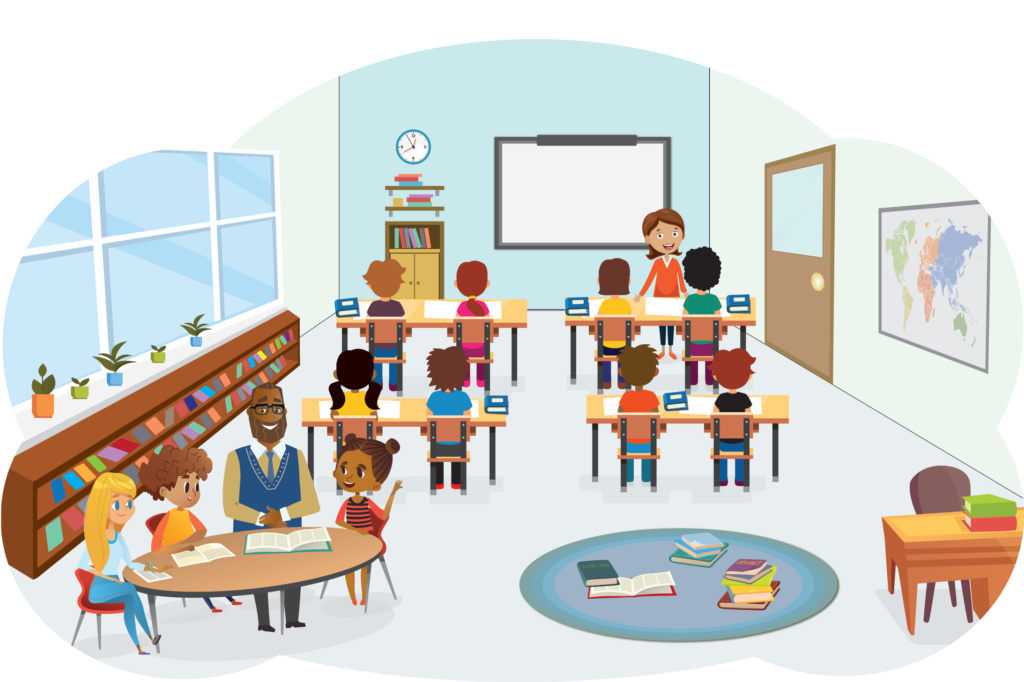ALL Students Receive High-Quality Instruction
 Instruction Designed to Meet Individual Strengths and Needs
Instruction Designed to Meet Individual Strengths and Needs
All students receive an academic and social-emotional curriculum that meets their individual needs and is aligned with national and state standards and best practices. APS often refers to this as differentiated instruction, meaning there is not a one-size-fits-all approach. Teachers plan lessons based on their students’ individual strengths and needs. For instance, some groups of students may need reteaching or additional practice, whereas another group has mastered a skill or content area and receives extension activities to expand their knowledge.
Diverse, Inclusive and Welcoming Environment
Teachers are intentional about building strong relationships and community within their classrooms. Students have voice and choice in their learning activities. Students see themselves reflected in their classroom, through diverse books, pictures on the walls, and sharing personal stories. Teachers take the time to know what is important to each of their students.
Tasks to Develop Critical and Creative Thinking and Communication Skills
The “Five C’s” are foundational principles developed by the Virginia Department of Education that help students meet the demands and expectations of modern society. These principles inform the Profile of a Virginia Graduate and set new expectations for student instruction as well as what skills students should have when they graduate. The Five C’s include critical thinking, creative thinking, communication, collaboration, and citizenship skills. Through application of these concepts across all subjects, grade levels and academic disciplines, students will be equipped with the knowledge and skills they need to succeed post-graduation.
Small Group Activities
APS classrooms are set up to facilitate collaboration and small group activities, as well as to encourage active engagement in learning. Some examples include: teacher-led small groups, student choice learning stations that target strengths and needs, and collaborative group work on tasks.
Specialized Services for Students with Disabilities, English Learners, and Gifted Students
When a student is found eligible for special education services, an Individualized Education Program (IEP) is developed with the participation of the school staff, the parents/guardians, and the student (when appropriate). An IEP is a statement of the special education and related services that will be provided to the student, which is updated at least annually throughout a student’s eligibility for special education. The IEP guides the specialized services and extra support the student will receive as part of the Tier 1, core classroom instruction.
To serve our English Learners, EL teachers and core-content teachers work together to ensure that English language development is integrated into instruction across all content areas and subjects. That happens within the core classroom for all students who are English Learners.
Both EL teachers and core-content teachers plan lessons that meet the Virginia Standards of Learning, as well as WIDA English Language Development Standards. WIDA stands for World-Class Instructional Design and Assessment. APS used WIDA tools and resources to support language development and provide quality instruction for multilingual learners.
Advanced students or students identified as gifted receive the following services:
-
-
- The classroom teacher works with the resource teacher for the gifted to develop and present appropriately differentiated learning experiences for gifted students within the general education classroom
- In the general education classroom setting with identified students grouped (minimum of 10) and through other small group activities developed to extend learning, based on ongoing data
- With teachers who are specifically trained in instructional needs of and curriculum written for gifted students
- Through curricula which are differentiated or extended from concepts in the general education curriculum, and when appropriate, through opportunities for acceleration and extension
-
Integrated Social-Emotional Learning (SEL) Lessons and Practices
-
-
- Social-emotional learning goes hand-in-hand with academics for all students
- Elementary schools incorporate daily time focused on SEL instruction many through Daily Morning Meeting/Morning Circle
- Secondary schools incorporate focused SEL instruction at least two-times-a-week, many during advisory periods
- Like academics, SEL lessons are developed based on individual strengths and areas for growth
- School curriculum aligns to the appropriate grade-band of the Virginia SEL Guidance Standards
-
Review, Practice and Reteach as Needed
Teachers work in teams to analyze classroom data on a regular basis to determine what review, practice, and reteaching is needed for each student and class. The data they analyze includes classroom observations, assignments, as well as assessments and the SEL survey for grades 3-12, which is administered twice per year to measure growth and student needs.
Assessments and Progress Monitoring
A combination of universal screeners and classroom data are used to monitor student progress across units and throughout the year to measure growth and inform instruction. More about Assessment
SOME Students Receive Extra Assistance
Additional One-on-One or Small Group Support
This is commonly delivered in a 30 minute block and provided three to five times per week for 6-8 weeks in addition to core instruction time.
Frequent Progress Monitoring and Review
Typically, this additional support is assessed and monitored for progress every 2-3 weeks.
A FEW Students Receive Intensive, Longer-Term Support
 One-on-One or Small Group Interventions in Area(s) of Need
One-on-One or Small Group Interventions in Area(s) of Need
This is commonly delivered in a 30-45 minute block and provided five times per week in addition to core instruction time. Instruction at this level is more intensive, focused, frequent and individualized.
Frequent Progress Monitoring and Review
Progress is usually monitored every week.
Referrals Where Needed for Additional Assessment
If, after the teacher and/or collaborative team have implemented interventions with fidelity for at least 5-6 weeks, the student is still not making anticipated progress, the teacher will make a referral to the Student Support Team.
 Contact
Contact  Calendars
Calendars Careers
Careers Engage
Engage  District
District
